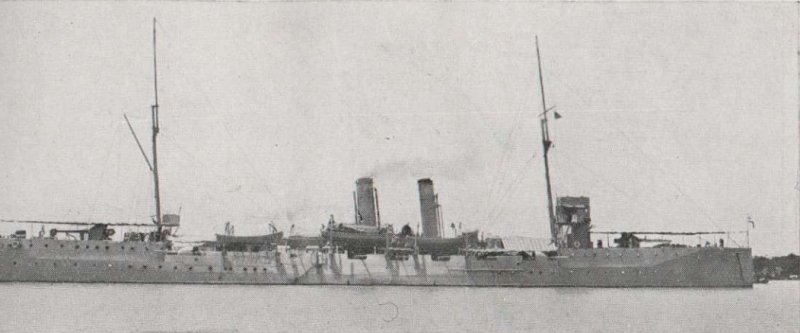
Training cruisers to Brit-US Yards
The Chao Ho class (肇和 or ‘Harmonious Beginnings’) were protected cruisers ordered by the Qing Dynasty in 1910 and later used by the Republic of China Navy. They fought in the Second Zhili–Fengtian War, Northern Expedition, Second Sino-Japanese War 1937 Second Sino-Japanese war, and in ww2. The third ship of the class, resold to the Greeks, fought in the Balkan wars as well.
The origins of the program were found under the supervision of Imperial regent Zaifeng, Prince Chun. He commissioned a very ambitious 7-year plan, asking for the modernization of the Imperial Chinese Navy, notably to compensate for the losses of the First Sino-Japanese war. In response, Prince Zaixun and Admiral Sa Zhenbing started a world tour, heading a purchase commission in the West in October of 1909, from Europe to the United States, before stopping in Japan in 1910. By its end, the Naval Commission had many suggestions, like the creation of a proper, unified Ministry of the Navy. On 4 December 1910, the Commission itself became the Ministry of the Navy, headed by Prince Zaixun (as its first minister). The main suggestion was to unite all three provincial fleets, before being divided again into three separate fleets to serve the Southern, Central, and Northern coasts of China. The modernization program comprised
massive ships such as battleships, cruisers, and of course torpedo boats and submarines.
Contracts for three new training cruisers were submitted internationally and eventually were awarded to two British yards and an American yard in 1910. The lead ship of this new class was to be named Chao Ho reflecting its training nature. She was laid down at the Armstrong Whitworth naval yard, Elswick, on 7 November 1910, and commissioned a year later. The second cruiser was named Ying Rui (應瑞; lit. or “Propitious Promise”) also known on Conways as “Ying Swei”. She was laid down at the Vickers Limited yard at Barrow-in-Furness and launched on 13 July 1911. The last ship ordered was Fei Hong (飛鴻; “Flying Swan”), laid down on 12 May 1912 at the New York Shipbuilding Corporation. She was completed in November 1913, but since the country was in revolution after the abdication of the Emperor, the order was cancelled. The new Chinese republic wanted to get rid of past debts and refused the cruiser.
The yard kept it to be resold, and after negotiation ending successfully on 14 May 1914, Fēi Hóng was sold to the Kingdom of Greece, renamed Elli. At that time, a conflict with Turkey was very likely. Elli was still active in WW2 but was reclassed as a destroyer. She was very different from the other two.
Design of the Chao Ho class
The two British-built Chao Ho-class cruisers were typical protected cruisers of the time, nearly identical to 1900s Vickers cruisers, a general design that had plenty of time to develop and was tried and tested. They had two funnels, two masts, a forecastle and poop decks, two main axial guns on the main decks forward and aft, and secondary guns in sponsons along the lower deck. However, the two British-built cruisers still differed in small ways due to their respective yard’s design alterations. It was the same basic design, as defined by the Chinese, but they varied in size, displacement, armour, and boiler types, as well as in their artillery. This variety was wanted, specifically to have a sample of various ship designs and configurations in order to have three different training vessels, bringing cadets some variety, raising educational effectiveness, and familiarizing the crews with various machinery and weaponry.
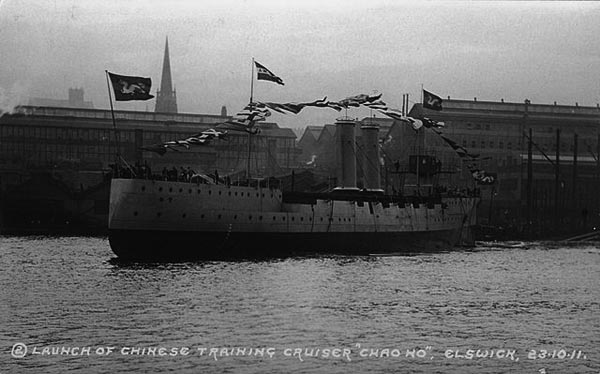
Hull design
Chao Ho’s was designed to be larger than her two sisters, 2 feet 6 inches (0.76 m) beamier, for 290 tonnes more. Ying Swei had a different foremast, which was stepped further aft and had more widely spaced funnels. The Chao Ho also had thicker armour, with 2 in (51 mm) for the main deck, versus her sister ship's 0.75 in (19 mm) on the main deck and 3 in (76 mm) and 1.75 in (44 mm) from her conning tower. She was a protected cruiser, so no belt armor was mounted, but an armoured deck was, along with guns shields, and an armoured conning tower. Her sister ship was smaller, 330 feet (100 metres) long by 39.5 ft (12.0 m) in beam, and its draught 13 ft (4.0 m). Displacement was lighter, at 2,460 long tons (2,500 tonnes).
Jing Swei was smaller, displacing 2,115 long tons (2,149 t) standard, and 2,600 long tons (2,642t) fully loaded. The hull was the smallest of the three, 98 m (321 ft 6 in) in length, a 12 m (39 ft 4in) beam, and a draft of 4.3 m (14 ft 1 in).
Powerplant
Chao Ho was fitted with three-shaft Parsons steam turbines, mated with 4 cylindrical and 4 Yarrow boilers which developed a total of 6,000 hp (4,500 kW). Due to this mixed powerplant, the Chao Ho could reach a top speed of 20 knots (23 mph; 37 km/h), for an overall range of 4,500 nautical miles (8,300 km), at 10 knots (12 mph; 19 km/h).
Jing Swei (Jing Rui) was fitted with the same arrangement, three-shaft Parsons steam turbines, two cylindrical, and 4 White-Foster boilers. She developed a total of 6,000 hp (4,500 kW). Her top speed was the same, 20 knots, with a better range of 5,000 nmi (9,300 km) at 10 knots.
The third cruiser, Fei Hung was given three shafts parson turbines, fed by three Thornycroft water-tube Boilers for a total of 6,000 shp. She was the slowest of the three, topping at 18 knots. She carried 400/60 tonnes of coal, and 100 tonnes of oil.

Two view design of the class
Armament
Chao Ho’s primary armament consisted of:
-Two Armstrong Pattern NN 6-inch (152 mm)/50 guns, mounted on the forecastle and poop.
-Four 3-inches/50 (76 mm) in hull recesses at the poop and forecastle break.
-Six 3-pdr guns (37 mm) on the sides
-Two 1-pdr gun (20 mm) on the sides
-Two 18-inches torpedo tubes, fixed above water, aft of the bridge.
Ying Swei was armed with different, shorter main guns: the Vickers Mark J, 6-inch (152 mm)/45. Her secondary armament was heavier, made up of four 4-inch (100 mm)/50 guns, four 14pdr QF guns, six 47mm/40 Hotchkiss guns, and two 37 mm (1 in) Maxim guns for light armament (same placement) and the same above water two 18 in (457 mm) torpedo tubes.
The third vessel was also armed differently, with three 6-inch (152 mm) masked guns, one forward, one aft, and one on a platform in between funnels. She was given a lighter secondary armament too with just two 3-inch (76 mm) guns, and three 40 mm (1.6 in) AA guns, though she had larger above-water 19-inch (483 mm) torpedo tubes, being of a rare caliber, seldom used. The decks had the capacity for transporting 100 mines on rails, another difference from the two other vessels.

Author’s illustration of the Chao Ho class
Chao Ho class Specifications |
|
| Dimensions | 105.5 m (346 ft) Beam 13 m (43 ft) Draught 4-4.3 m (15 ft) |
| Displacement | 2,500-2,750 t (2,707 long tons) |
| Propulsion | Three-shaft Parsons ST, 4 cyl. 4 Yarrow boilers, 6,000 hp (4,500 kW) |
| Speed | Top speed 20 knots (23 mph; 37 km/h) |
| Range | 4,500 nmi (8,300 km) at 10 kn (12 mph; 19 km/h) |
| Armament | 2x 6-in/50, 4x 3 in/50, 2x 3 in, 6x 3-pdr, 2× 1pdr, 2× 18 in TTs aw |
| Armor | Deck: 19-51 in, CT 3 in (7.6 cm) |
| Crew | 331 |
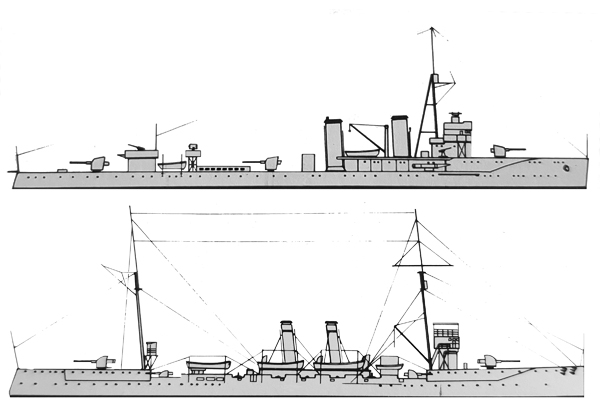
Conways profiles: Helle as rebuilt in france, and the original Chao Ho class below.
Src/Read More
Rhoads, Edward J.M.. Manchus & Han: Ethnic Relations and Political Power in Late Qing and Early Republican China, 1861-1928.
Wright, Richard N.J.. The Chinese Steam Navy 1862–1945. Chatham Publishing
Gray, Randall. Conway’s All the World’s Fighting Ships, 1906-1921
Friedman, Norman (2011). Naval Weapons of World War One. Barnsley: Seaforth.
Gardiner, Robert (1997). Conway’s All the World’s Fighting Ships, 1906–1921. London: Conway Maritime Press
.
Rhoads, Edward J.M. (2000). Manchus & Han: Ethnic Relations and Political Power in Late Qing and Early Republican China, 1861–1928. Seattle: University of Washington Press.
Wright, Richard N.J. (2000). The Chinese Steam Navy. London: Chatham Publishing
Gray, Randall. Conway’s All the World’s Fighting Ships, 1906–1921, Volume 2. Conway Maritime Press, 1985, pp. 396–397.
https://www.barrowbc.gov.uk/pdf/17%20Chinese%20Sailor%20draft%202.pdf
https://en.wikipedia.org/wiki/Chao_Ho-class_cruiser
Chao Ho in service
Chao Ho was ordered at Armstrong Whitworth, laid down on the 7th of November 1910, launched about one year later on 23 October 1911, and completed on 21 February 1912. She travelled to China and was commissioned later in 1912 but saw no service until December 1915.
At that time, China was in a virtual civil war. She was briefly captured by Southern Chinese rebels, during the "National Protection War". During the "Warlord Era" of the Republic of China in the 1920s, Chao Ho was often called to shell rebel positions.
In December 1923, the Zhili Clique Warlord, Wu Peifu, took the head of the Beiyang Government, and soon bribed half of the Chinese Navy into his personal service, reconstructing the famous Beiyang fleet of old. This fleet had the Chao Ho at its centerpiece, and it was anchored at the naval base of Qingdao (former German Empire's Kiautschou). It was the most advanced port in China and contained a squadron composed also of the cruisers Hai Chi, Hai Chen, and the gunboats Yung Hsiang and Chu Yu. From 5 January 1924, this squadron officially became the "Northern Fleet".
However, the Zhili Clique was defeated during the Second Zhili–Fengtian War and control of Qingdao passed to the Manchurian warlord Zhang Zuolin (Fengtian clique).
The Northern Fleet was renamed the North East Fleet but suffered greatly from neglect after all these years. Crews were poorly trained, ammunition was found to be lacking, and in general, the ships were in a state of total disrepair with rusty hulls. At best, Chao Ho at the time was barely able to reach 10 knots. Zhang Zuolin, close politically to the Empire of Japan sent Chao Ho and other vessels from the fleet to be refitted in Japan in 1927. The irony would be that ten years later the same nation would also sink them.
In 1927, the Kuomintang Government led by Chiang Kai-shek launched his Northern Expedition and finally brought an end to the Northern Chinese warlords. Even with its newly trained National Revolutionary Army, the Kuomintang still could not put its hands on the Navy, which stayed loyal to Zhang. In 1927, Chao Ho returned from Japan in a perfect state (It seems no significant changes were made to the armament or powerplant, however) and was eventually manned by a new crew. She started offensive sorties to shell Nationalist naval fortifications at Wusong, off the coast of Shanghai. Chao Ho also covered the brief occupation of the island of Kinmen off the Xiamen coast, in May 1928.
The Kuomintang eventually captured Beijing in 1928. Zhang was eventually betrayed by the Japanese, killed when his train he was blown up by Japanese officers of the Kwangtung Army, in retaliation for his failure in defeating Chiang Kai-shek. His son, Zhang Xueliang pledged allegiance to Chiang Kai-shek and former North East Fleet officially integrated the Republic of China Navy. In 1930, the only modification on Chao Ho was the addition of two QF 2 pounder anti-aircraft guns on a platform, at the base of the mainmast. The North East Fleet became the Third Squadron, still based in Qingdao.
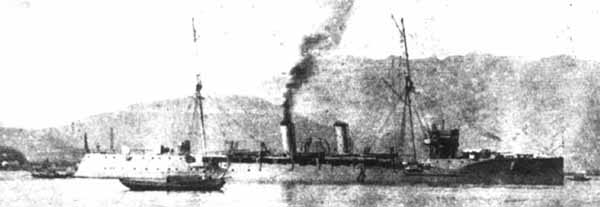
Chao Ho in the 1930s.
The Kuomintang eventually captured Beijing in 1928. Zhang was eventually betrayed by the Japanese and killed when the train he was on was blown up by Japanese officers of the Kwangtung Army in retaliation for his failure in defeating Chiang Kai-shek. His son, Zhang Xueliang pledged allegiance to Chiang Kai-shek and the former North East Fleet officially integrated the Republic of China's Navy. In 1930, the only modification on Chao Ho was the addition of two QF 2-pounder anti-aircraft guns on a platform, at the base of the mainmast. The North East Fleet became the Third Squadron, still based in Qingdao.
In July 1933, a lieutenant from the gunboat Chen Hai discontent with poor wages tried to kill Admiral Shen Hung-lieh, who was also the mayor of Qingdao. He was executed but in solidarity, the Third Squadron (ROC Hai Chi, Hai Chen, Chao Ho) mutinied. The crews decided to sail to Guangzhou (under general Chen Jitang). In the wake of the Northern Expedition, the situation was still troubled and cliques reappeared. Mutineers were welcomed by the city and crews were pressed into the Cantonese faction. Still, the fleet remained underpaid and underemployed and mutiny leader Rear-Admiral Kiang Hsi-yuan was forced out and replaced by a local Cantonese commander, triggering a new mutiny. The fleet left Guangzhou on 15 June 1935 but Chao Ho soon hit the bottom and remained for a time stuck in the mud. Meanwhile, Hai Chi and Hai Chen encountered the Nationalist cruiser Ning Hai (admiral Chan Chak on board) and made a stand.
There were warning shots but negotiations started and the situation diffused on 18 July.
Meanwhile, Chao Ho was freed and joined both cruisers, after being informed of the new situation. Until 1937 the fleet was back in their home port and nothing much happened. But this soon changed.
The second Sino-Japanese war saw the capture of Beiping and Tianjin while Chao Ho was stationed at the naval fort in Bocca Tigris, defending Guangzhou and the mouth of the Pearl River. On 14 September 1937, she joined Hai Chi (a former British Arabis-class sloop), and both engaged the IJN Yūbari and destroyers Hayate and Oite. They were forced to retreat, being covered by land-based Chinese artillery on Bocca Tigris. Japan sent the aircraft carriers Ryūjō and Hōshō to launch raids against the forts and also targeted the damaged ships at the entrance of Pearl River. They also launched raids against the whole Pearl River Delta and Guangzhou. On 30 September 1937, Chao Ho was targeted by one such IJN bomber raid. Her poor AA was of no help and she received several hits and eventually sank, though the exact circumstance of her loss are foggy at best. She was later refloated and scrapped by Japanese occupation forces.
Ying Swei (Ying Rui) in service
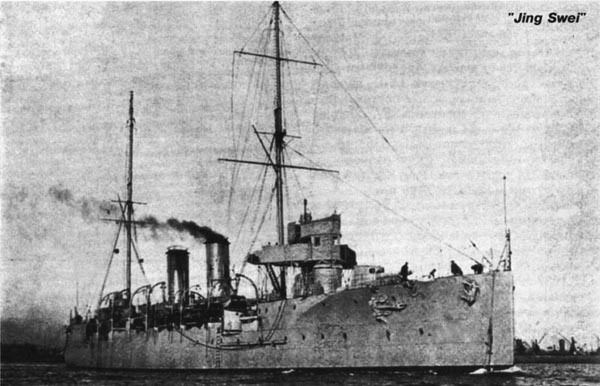
Ying Swei (or Ying Rui) was laid down at Vickers, Barrow-in-Furness in late 1910, launched on 13 July 1911, and was completed and started her sea trials in the UK by 2 December 1911, barely six months after launch, showing the efficiency of Vickers yards at the time. Her Chinese crews arrived and started training on the River Clyde. The initial crew of British sailors was supplemented by men from the cruiser Hai Chi also in Barrow-in-Furness. Trials were completed successfully by the 9th of December 1911 but still, she was not delivered due to the tense situation in China. After a long loan negotiation, she was eventually delivered to China in April 1913 and designated as a training cruiser of the Republic of China's Navy. In mid-1917, Admiral Sa Zhenbing commanded both Ying Rui and Chao Ho. He was ordered to send his cruisers to shell positions held by rebels of the Manchu Restoration but refused. In 1920 Ying Rui was based in Nanjing.
In July 1923, Ying Rui and Hai Yung departed Shanghai to attack Amoy (Xiamen), preventing navy defections to the Beiyang Government. This was a success and the city was re-taken by a simultaneous land assault. Ying Rui took part in many major operations with the Central Fleet, her crew eventually swearing allegiance to the Kuomintang on 14 March 1927 (during the Northern Expedition). In 1933, Ying Rui returned to her training role with the old Tung Chi and transport Ching A. By late June 1935, Ying Rui was sent to Hong Kong after the mutiny of Chao Ho, Hai Chi, and Hai Chen.
When the Second Sino-Japanese War broke out, Ying Rui was in the Central Fleet with the brand new Ning Hai, Ping Hai, and the older Yat Sen, stationed at Jiangyin, the entrance of the Yangtze. On the 14th of August 1937, the Imperial Japanese Navy started aerial attacks (Battle of Shanghai) and started to target Jiangyin. Air raids were made from Ryūjō, Hōshō, and Kaga, targeting the Chinese fleet. By the end of September, Ying Rui was the last remaining cruiser, surviving a previous attack. It was then decided to send her to safety in Nanjing. By mid-October 1937 the Central Fleet no longer existed and Ying Rui was disarmed, her guns transferred to the army to be used in the defense of Nanking. On the 24th of October 1937, the removal process was ongoing when she was attacked by Japanese dive-bombers and eventually sank, with a large part of her artillery remaining.
The fate of Fei Hong
Cancellation and sale to Greece
Cancellation and sale to Greece
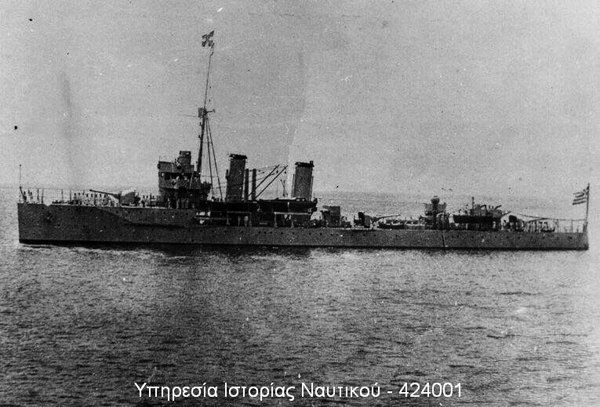
Elli in 1940.
Fei Hong was ordered on a similar general layout as her sister ships, but her fate was very different: Originally one of three cruisers, the "Flying Swan" was the only one built in an American Naval Yard: New York Shipbuilding. Started on 14 June 1911, and launched on 4 May 1912 she was completed on November 1913. However the situation in China changed dramatically since her purchase, as the Nationalist revolution in 1912–13 saw the fall of the Imperial government, and the new authorities declined to pay for the cruiser. The purchase was later formally cancelled, leaving the yard with a completed cruiser without a buyer in 1914. The US Government had no use for it, so Fei Hung was available on the market. Due to the degrading situation in the eastern Mediterranean, she was sold eventually to Greece, as part of its naval expansion program after the Balkan Wars. She was renamed Elli and transferred to Greece in 1914. The war broke out but Greece remained neutral initially.
Greek neutrality was not easy though, as Prime Minister Eleftherios Venizelos favoured the Entente and King Constantine favoured the Central Powers. The political conflict grew into a “National Schism”. In November 1916, the French wanted this crisis resolved and Greece was forced to join the Entente. The French threatened Athens with their fleet and sent marine troops to confiscate Greek ships in Piraeus. Elli was captured also, and continued operations, albeit with French crews. She was deployed in convoy escort and patrol duties in the Aegean and was crewed by the Greeks again when at last Athens resolved the question by leaving neutrality and officially joining the entente in June 1917. The Greek Navy took part in the Aegean campaign and deployed Elli with Giorgios Averoff in several operations. During the Asia Minor Expedition, King Paul of Greece was sub-Lieutenant on board Elli and was present in Smyrna in September 1922.
Reconstruction and WW2 service
After the war, she was sent to be reconstructed in France with Georgios Averof. Her aspects changed considerably and she received modern anti-aircraft armament plus mine laying equipment. Her hull was also radically modified, giving her her final look. In WW2, the cruiser Elli was partaking in operations when she was spotted by the Italian submarine Delfino. At that time, Greece was at peace with Italy, but the submarine sank her anyway, at 8:25 am on 15 August 1940, while she sailed off the island of Tinos, participating in celebrations of the Dormition of the Theotokos. One torpedo hit her boiler, which caught fire, and finally, she sank, carrying with her to the bottom 8 petty officers and sailors while 24 others were wounded.
The Greek government later established the Italians were at the origin of this, recovering torpedo fragments, but tried to avoid a confrontation and announced the nationality of the attacking submarine was unknown. The Greco-Italian War would break anyway two months later. After the war, Italy gave as compensation the cruiser Eugenio di Savoia, commissioned under the same name served from 1950 to 1973.

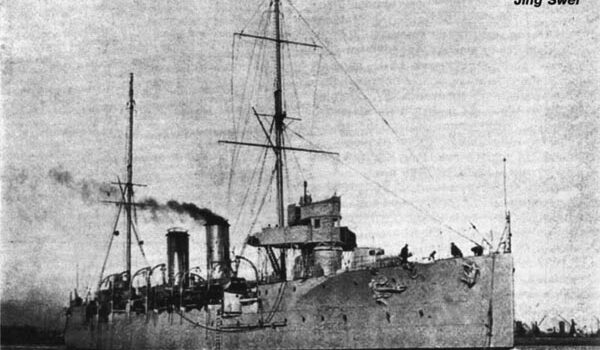

 Latest Facebook Entry -
Latest Facebook Entry -  X(Tweeter) Naval Encyclopedia's deck archive
X(Tweeter) Naval Encyclopedia's deck archive Instagram (@navalencyc)
Instagram (@navalencyc)





 French Navy
French Navy Royal Navy
Royal Navy Russian Navy
Russian Navy Armada Espanola
Armada Espanola Austrian Navy
Austrian Navy K.u.K. Kriegsmarine
K.u.K. Kriegsmarine Dansk Marine
Dansk Marine Nautiko Hellenon
Nautiko Hellenon Koninklije Marine 1870
Koninklije Marine 1870 Marinha do Brasil
Marinha do Brasil Osmanlı Donanması
Osmanlı Donanması Marina Do Peru
Marina Do Peru Marinha do Portugal
Marinha do Portugal Regia Marina 1870
Regia Marina 1870 Nihhon Kaigun 1870
Nihhon Kaigun 1870 Preußische Marine 1870
Preußische Marine 1870 Russkiy Flot 1870
Russkiy Flot 1870 Svenska marinen
Svenska marinen Søværnet
Søværnet Union Navy
Union Navy Confederate Navy
Confederate Navy Armada de Argentina
Armada de Argentina Imperial Chinese Navy
Imperial Chinese Navy Marinha do Portugal
Marinha do Portugal Mexico
Mexico Kaiserliche Marine
Kaiserliche Marine 1898 US Navy
1898 US Navy Sovietskiy Flot
Sovietskiy Flot Royal Canadian Navy
Royal Canadian Navy Royal Australian Navy
Royal Australian Navy RNZN Fleet
RNZN Fleet Chinese Navy 1937
Chinese Navy 1937 Kriegsmarine
Kriegsmarine Chilean Navy
Chilean Navy Danish Navy
Danish Navy Finnish Navy
Finnish Navy Hellenic Navy
Hellenic Navy Polish Navy
Polish Navy Romanian Navy
Romanian Navy Turkish Navy
Turkish Navy Royal Yugoslav Navy
Royal Yugoslav Navy Royal Thai Navy
Royal Thai Navy Minor Navies
Minor Navies Albania
Albania Austria
Austria Belgium
Belgium Columbia
Columbia Costa Rica
Costa Rica Cuba
Cuba Czechoslovakia
Czechoslovakia Dominican Republic
Dominican Republic Haiti
Haiti Hungary
Hungary Honduras
Honduras Estonia
Estonia Iceland
Iceland Eire
Eire Equador
Equador Iran
Iran Iraq
Iraq Latvia
Latvia Liberia
Liberia Lithuania
Lithuania Mandchukuo
Mandchukuo Morocco
Morocco Nicaragua
Nicaragua Persia
Persia San Salvador
San Salvador Sarawak
Sarawak Uruguay
Uruguay Venezuela
Venezuela Zanzibar
Zanzibar Warsaw Pact Navies
Warsaw Pact Navies Bulgaria
Bulgaria Hungary
Hungary

 Bundesmarine
Bundesmarine Dutch Navy
Dutch Navy Hellenic Navy
Hellenic Navy Marina Militare
Marina Militare Yugoslav Navy
Yugoslav Navy Chinese Navy
Chinese Navy Indian Navy
Indian Navy Indonesian Navy
Indonesian Navy JMSDF
JMSDF North Korean Navy
North Korean Navy Pakistani Navy
Pakistani Navy Philippines Navy
Philippines Navy ROKN
ROKN Rep. of Singapore Navy
Rep. of Singapore Navy Taiwanese Navy
Taiwanese Navy IDF Navy
IDF Navy Saudi Navy
Saudi Navy Royal New Zealand Navy
Royal New Zealand Navy Egyptian Navy
Egyptian Navy South African Navy
South African Navy






























 Ukrainian Navy
Ukrainian Navy dbodesign
dbodesign